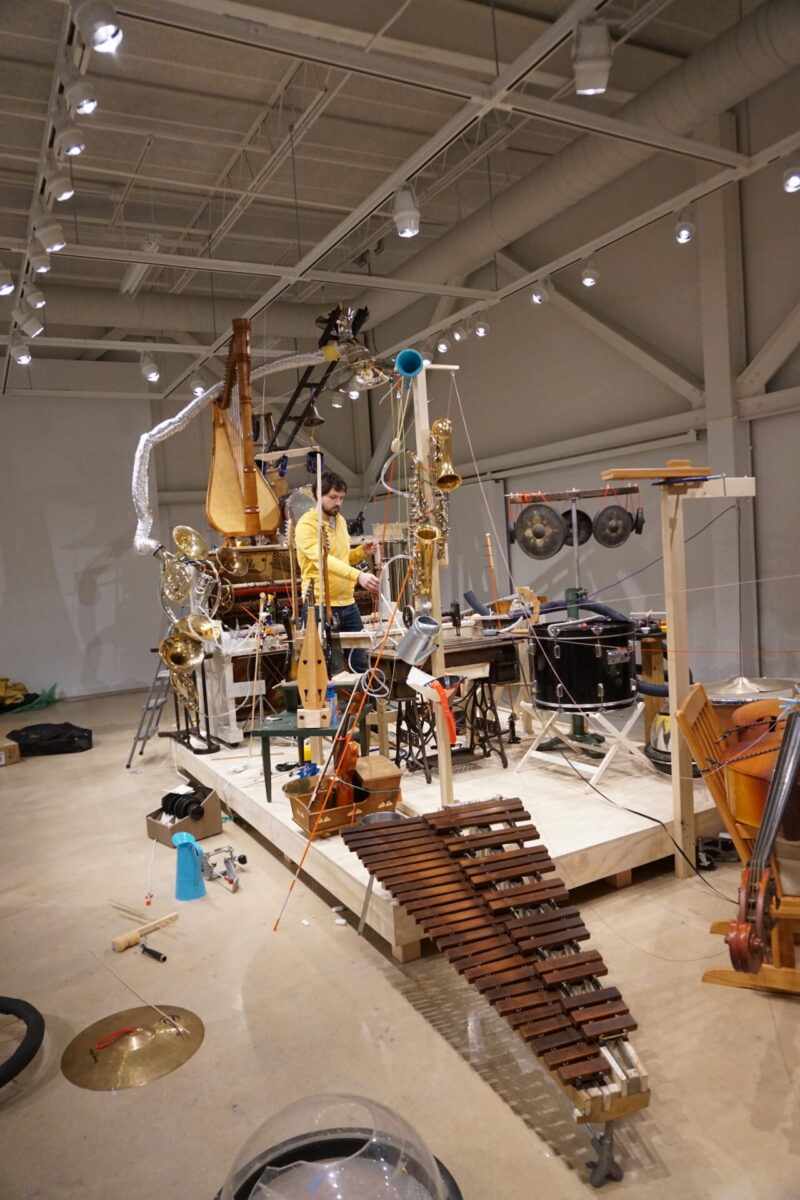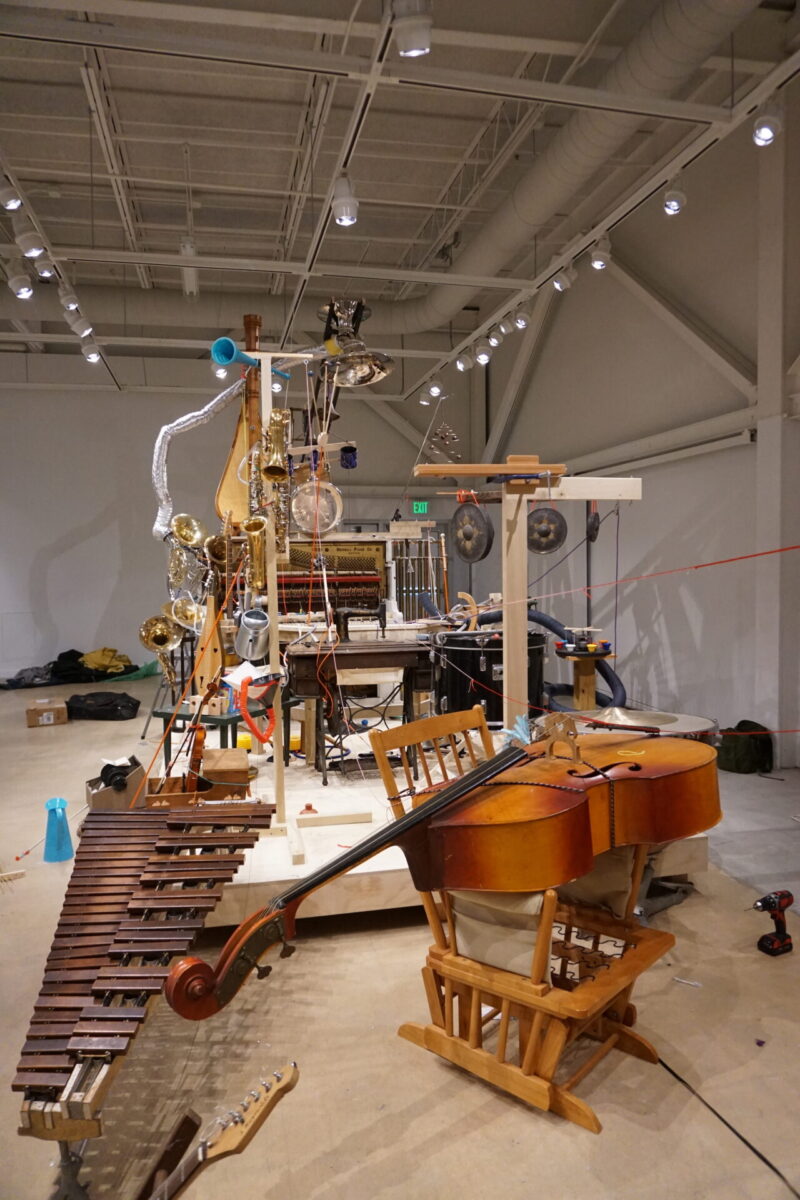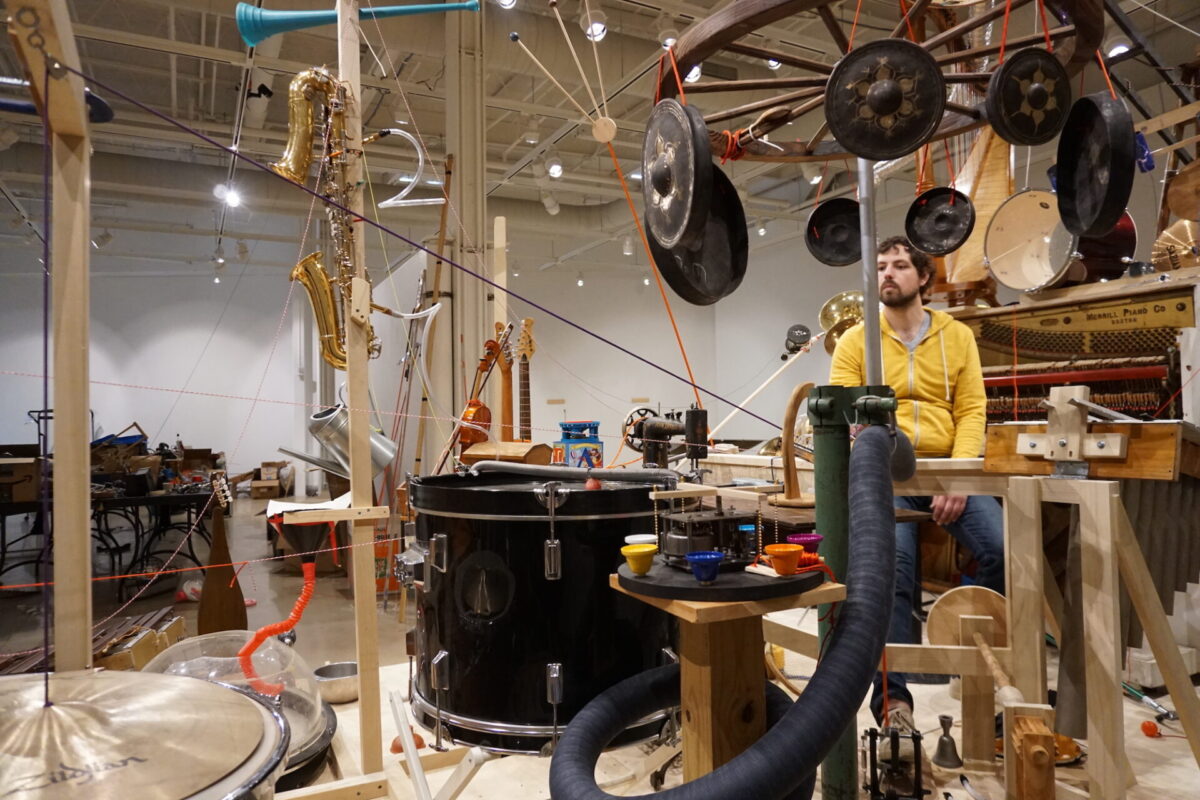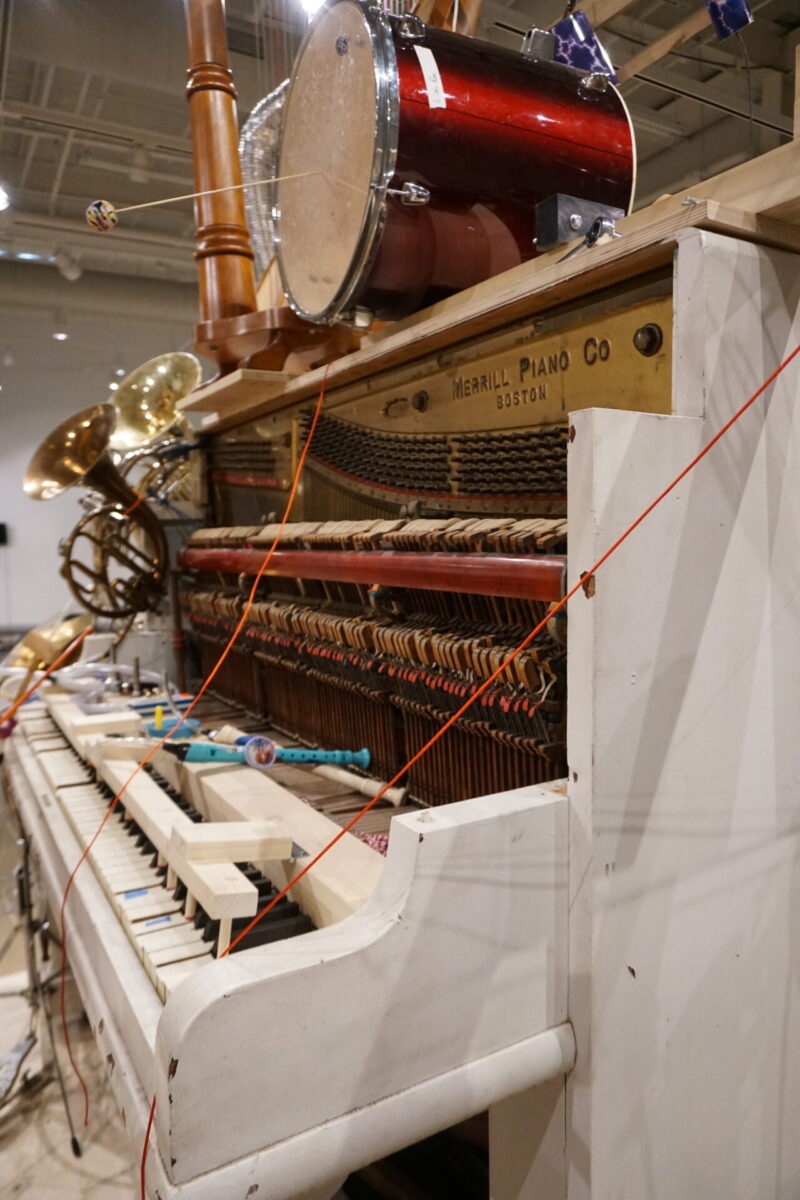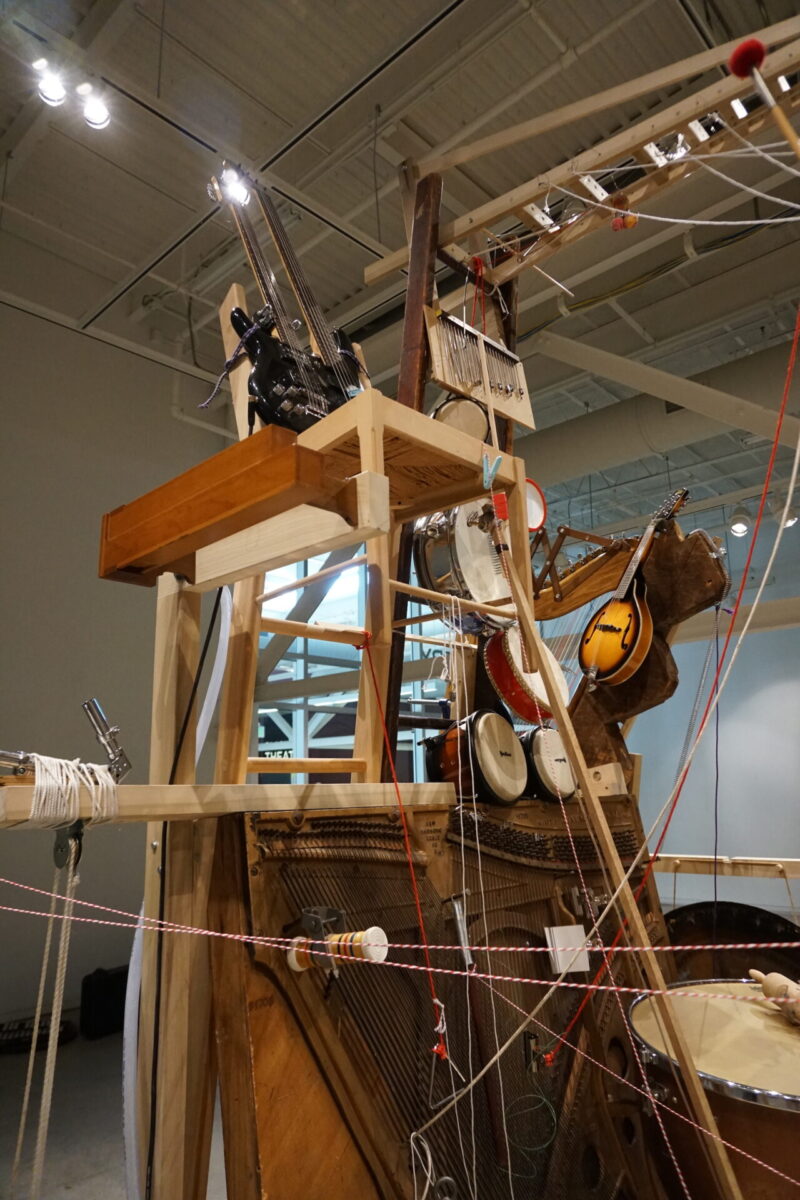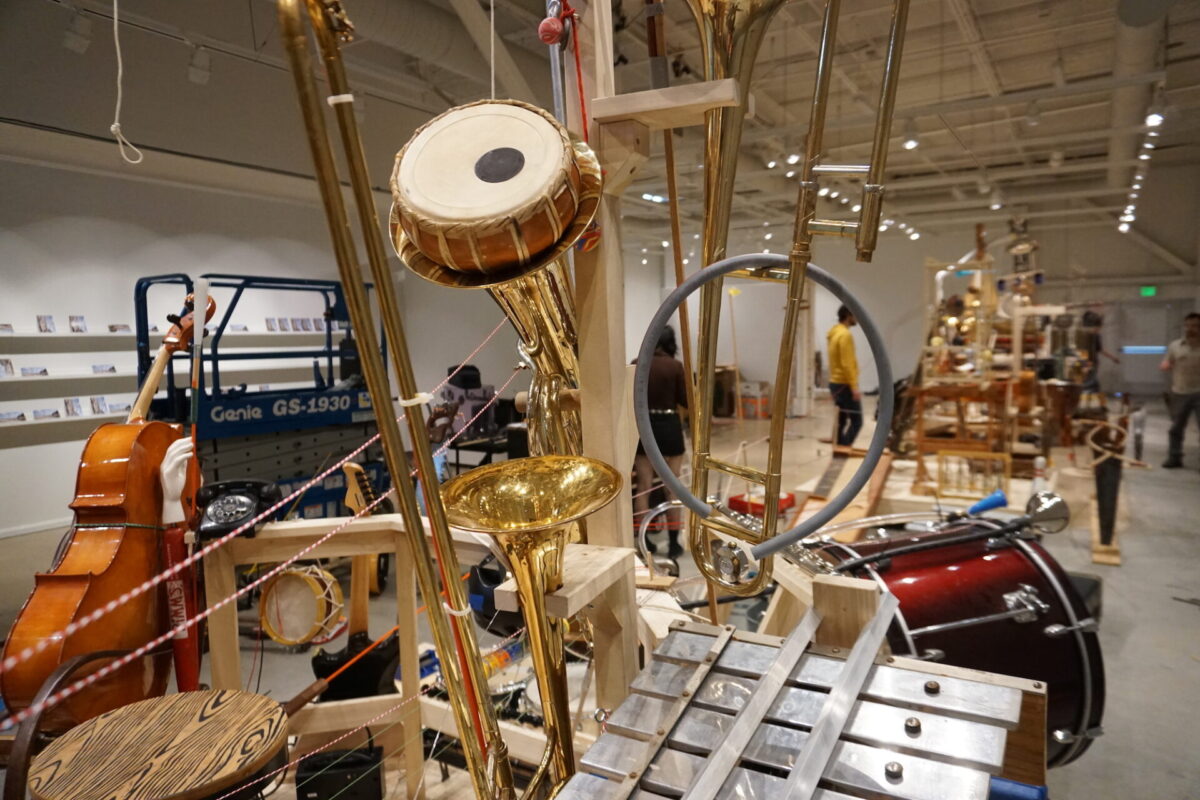
Curiosity and Chaos: Zwei Mann Orchester finds readymade music in the sounds of every day
“You are seated in the cockpit of a fantastical, Rube Goldberg-like machine. All around you is a forest of strings, rods, levers and all manner of other movable elements. Using your hands, feet, body, and head, even the smallest gesture to set forth a visible chain reaction of producing the entire timbral range of the orchestra.” – From the introduction to Bowerbird’s performance of Mauricio Kagel’s Zwei Mann Orchester
The room is massive. You can tell that the second you walk in. But the musical contraptions spread out everywhere seem to fill it up top to bottom. There are guitars balanced seemingly precariously over drums, a cello held in place on top of a rocking chair with a rope and pulley attached to one leg, a huge harp mounted on top of a piano with what looks like some dryer tubing wrapped around it, and … is that a sewing machine?! According to Bowerbird Director Dustin Hurt, who is overseeing the construction of Mauricio Kagel’s Zwei Mann Orchester that’s premiering tonight, the idea behind the composition is that, “Music is not just limited to what we do in the concert hall. Music can be found in everyday objects and in sort of the sounds of things that we already hear everyday.”
That explains the sewing machine. And the device that is scooping water with wine glasses, creating a kind of soft slushing sound. Really it explains everything that’s set up in this giant Drexel art gallery – traditional instrument or not – because as anyone who has ever tapped their fingers against a table or found a pattern in the cacophony of car horns can tell you: it’s all music if you want it to be. The question then becomes how you fit it all together.
https://www.instagram.com/p/BiPzCbShmgU
When the German-Argentine Kagel created the Zwei Mann Orchester in the early 70s, it was as a performance of both music and movement. Indeed, the notation for the composition includes notes for not just how the instruments should be laid out but also for how the musicians themselves should interact with them. That being said, it’s not specific on the instrumentation, more the geography of the room and the way things are to be played: there are two platforms on opposite ends of the room that serve as control rooms for each of the musicians, who will be continuously seated for the duration of the approximately 50 minute long performance. In between them, with instruments controlled by both musicians through a system of levers and strings and other Rube Goldberg-esque devices, is a third platform. With a “maraca tree” in the middle of it. Really.
This will be the first time the piece will be heard in the United States and only the fourth time it’s ever been performed. This is clearly a very epic endeavor. Hurt told The Key that, “I’ve presented six hundred and some odd concerts and this is the first I think actually experimental – in the kind of empirical sense – project I’ve worked on. For each of the 140 instruments that are here we’ve probably developed ten prototypes. In the last month we’ve pretty much been [here] from 10 a.m. to midnight every day.”

Zwei Mann Orchester | photo by Yoni Kroll for WXPN
Hurt described one of the instruments – the harp with a bouncy ball on a string thwacking against it – as having, “a nice mixture of curiosity but also chaos,” which is something that could really be the tagline for the entire performance.
Kagel’s work as both a composer and an artist and filmmaker was rooted in what he called ‘instrumental theater,’ something Hurt described as, “The actual act of performing, the intention, the body positions, everything. Even if you’re doing the most simple thing like eating chips, you can make that a performative act.” That aesthetic was in part due to Kagel’s background in Dada and absurdism.
The musicians in the Orchester are not supposed to show any emotion while performing, Hurt explained, making a comparison to the classic concept of clowning where everything is relayed with a straight face. They are doing “humorous acts intentionally but without any awareness of it,” he said, in order to build anticipation or create feelings of surprise or shock in the audience.
The two musicians in charge of this 140 instrument kinetic sound machine are Andy Thierauf and Ashley Tini. They also helped put it together along with Hurt, sculptor Scott Kip, and instrument builders Neil Feather and Yona Davidson, all under the consultation of Wilhelm Bruck, an original Kagel collaborator as well as a musician and sculptor.
https://www.instagram.com/p/BiI77pXFNPf/?taken-by=bowerbird_philly
Thierauf is a percussionist and a Kutztown University professor who has collaborated often with dance and theater groups. He is a member of the Bowerbird-adjacent Arcana New Music Ensemble which has put on productions of composers including Julius Eastman, Morton Feldman, Pauline Oliveros, Moondog, and many others.
Tini is a musician and composer who sometimes performs and releases atmospheric folk under the name Jo Nelson; according to her website, “seeks to create altered states by challenging concepts of ritual and their relation to time and place.” Tini told The Key that being one of the musicians in the Orchester is, “… kind of a mindset. Once you do get into that space it’s almost sort of a Zen state. You’re so serious about what you’re doing that you forget you’re doing really ridiculous stuff.”
Zwei Mann Orchester opens at Drexel’s Pearlstein Gallery in the URBN Annex, and will be performed six times through May 24th. More information can be found here.
- Zwei Mann Orchester | photo by Yoni Kroll for WXPN
- Zwei Mann Orchester | photo by Yoni Kroll for WXPN
- Zwei Mann Orchester | photo by Yoni Kroll for WXPN
- Zwei Mann Orchester | photo by Yoni Kroll for WXPN
- Zwei Mann Orchester | photo by Yoni Kroll for WXPN
- Zwei Mann Orchester | photo by Yoni Kroll for WXPN
- Zwei Mann Orchester | photo by Yoni Kroll for WXPN
- Zwei Mann Orchester | photo by Yoni Kroll for WXPN


